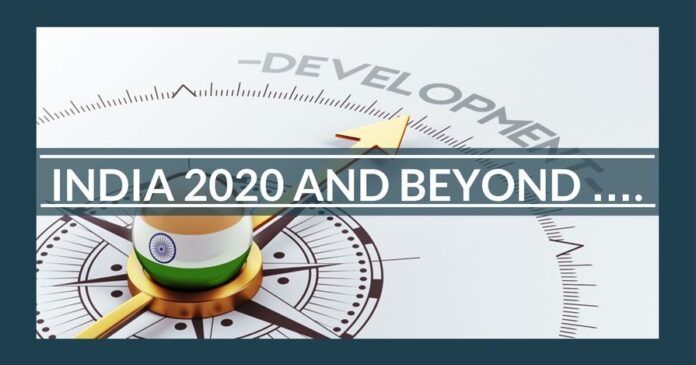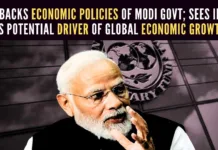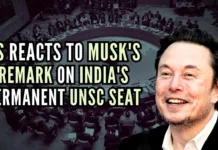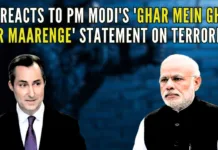
A compilation of doable series of initiatives which could help transform administrative governance in India.
As another year passes by and the debate rages hard in the electronic and print media of the achievements and failures of the Non-Congress Full majority Government in Power. Its amply clear as India completed 70 years of its post-independence from the British Raj that the great Indian democracy with its multipolar multi-party governance and frequent Elections conducted at various levels throughout the Country almost every other year is unable to allocate adequate timespan or build suitable consensus to deal in an effective timely manner with the sheer magnitude of myriad problems facing India today.
The Constitutionally mandated system of sharing authority between Centre & States on crucial subjects of daily governance often results in buck-passing and lack of clear Central authority, poor Centre-State co-ordination and the absence of Political Will to devise and implement policies to ensure good governance which finally leads to either administrative neglect or hasty & weak responses to problems which obviously need more clear long-term solutions.
Its also been evident the Indian Administrative Service serving as the backbone of India’s Governance delivery service does not have requisite Domain expertise and powers to deal professionally with the many daunting challenges confronting the Nation today and quite often is part of the problem itself instead of being part of the Solution.
The IAS & IFS bureaucracy has lacked deep dive reforms over the years to modernise and prepare themselves to professionally fulfil the huge administrative responsibilities to guide, manage the elected representatives in Government to deliver on the Electoral promises as this British era institution workload seems struck and lost in translation between the Political establishments and its National duties.
The IFS diplomatic corps is said to be seriously short staffed and short Skilled to meet new challenges & responsibilities of India’s integration into the World economic gridlock today.
But even if India’s Political leadership is able to set the right incentives for government rank and file to improve their working as attempted by the Modi Govt, the general viewpoint of many leading experts in India, there still remains the question of competence in the Indian Administrative structural system. Are officials suitably trained ?? Do they have periodic Skills upgrade reviews ?? And there is an even more fundamental challenge than skills and training: across almost all dimensions, India’s public sector institutions are grossly undermanned. In many parts of the country, the State lacks presence. In a way, this mirrors the debate raging across capitals of the industrialised world about “rightsizing” the State. There is one key difference, however, in the Indian context: it is not about modifying the Indian state but—in many corners of the country—building it from the ground up for the first time.
Expanding State capacity without disturbing the Federal administrative structure and polity has been the real challenge for any Government in Power
There is the major broader lesson here ……
The ongoing fiscal decentralisation and other key reforms by the ModiGovt are all welcome moves but India still needs an effective Union Government with adequate Constitutional powers to hold a vast diverse complex country together socially and economically.
Its quite obvious while Modi Govt has indeed attempted many bold initiatives and still has time in Office but based on evidence so far it has failed to make any major visible qualitative improvement in the quality of government services rendered to the Public at large and ensuring Equal economic growth opportunities all of which continue to pose serious administrative challenges for any Government in power in India.
The most obvious question to all these administrative challenges is, does Modern India need a new transparent professional institutional architecture to deal with multi State subjects of daily governance ????And the emphatic answer is Yes and possibly the panacea to all major problems of democratic India in the 21st Century.
India’s poor State Capacity & its fallout in recent years has been extensively discussed and debated in India but expanding State capacity without disturbing the Federal administrative structure and polity has been the real challenge for any Government in Power !!!
As India’s challenges mount, the need for institutional reforms is vital to build a New India for the 21st century as Weak public institutions are the real reason behind India’s low state capacity. As many experts have pointed out it is not a matter of choice anymore, but for survival and growth as a Modern Nation State. Its imperative for India to swiftly expand the strength of State capacity to execute the vision of a New India !!!
The most recent example of State administrative reform was the abolishing of Planning Commission and establishment of NitiAayog as a platform for Co-operative federalism to facilitate the working together of the Union and the States as equals but over the last few years of its functioning its been painfully evident that it is not enough to outline a vision without revealing a path for its speedy effective implementation. Abolishing Old Institutions and replacing with New ones for and by the same bureaucrats is also not the path to Institutional reforms as proven in India but instead fixing its powers of operational freedom and ensuring the best-trained field experts administer these Institutions with independence, authority, accountability & responsibilities clearly defined as per Constitutional Laws which is the key to Institutional reforms in India.
NitiAayog continues to be a great opportunity for Field Specialists from various verticals outside Government to officially enter Government service and work alongside the Indian bureaucracy on crucial policy design and implementation programmes across India. However, NitiAayog first needs independent Constitutional powers of authority to work with Central & State Governments on various Government service delivery subjects of importance to the Nation.
The Quality of Human Resources in the Federal Institutions also ensures the best most advantageous & Out of Box solutions are available to Elected Govts to ensure the common public good of the Country.
India desperately needs new transparent, robust & accountable Federal structure of institutional architecture to deal with its diverse nature of multi-State subjects of National importance such as Environment, Education,Tourism,Power, Healthcare & Sanitation, Urban & Rural Civic infrastructure, Fiscal & Foreign Policy, Law & Order, Defence & Security and Judiciary to assist elected Government in Power to expand its Official State capacities to deliver effective governance in the country.
The Federal Institutional structure should be empowered with adequate Constitutional powers of authority and accountability to deal with all Federal negotiations especially to resolve the Inter-State & Centre-State rivalries due to multiple Political parties in power which often leads to poor or delayed implementations of crucial policy initiatives or perpetual Policy paralysis. The establishment of an independent Federal Institutional structure with Domain expertise credibility will help assist the Union Government and step in as focal co-ordinating agency authorised to get the States and Central Govt Ministries to the bargaining table and ensure crucial policy initiatives are designed and implemented in a timely effective manner.
A key feature of the Indian Constitution in our federal system is the two-tier system of Government with well-assigned powers and functions. The Central and the State governments are supposed to work in coordination and at the same time act independently. The federal polity, in other words, provides a constitutional device for bringing unity in diversity and for the achievement of common national goals.
Thus the Federal Institutional Authority should be designed to give due cognizance to the Federal structure of the Indian Union respecting the Structure and Rights in the Federal system as per India’s Constitution thus primarily aid to facilitate speedy implementation of common National goals of priority set by Central Govt for the citizens of India. The powers of Authority & Accountability of these Federal Institutions can be transparently monitored and regulated by Constitutionally mandated Laws to ensure these Institutions work with elected Central and State Governments as a facilitator and promoter of good governance.
A transparent Federal Institutional structure can fill the huge administrative delivery services vacuum to ensure crucial governance delivery subjects of National priority are not lost in the din of Political One-upmanship and narrow Electoral Vote gains pursued invariably by all Political Parties vying for Power in India …
Equally important is the independent Professional and ethical Credibility audits of Human Resource Content selected to serve Federal Institutions so Solutions to National problems can be resolved in an unbiased and timely manner without creating Political rivalries and turf wars. The Quality of Human Resources in the Federal Institutions also ensures the best most advantageous & Out of Box solutions are available to Elected Govts to ensure the common public good of the Country.
The need of the hour for present Government in Power struggling to successfully implement even well-intended Policies like Demonetisation, GST, Make in India, Digital India etc amongst many other such Policy initiatives is to create strong federal Institutional architecture to restore and augment the Constitutional Authority of the Union Govt to deliver timely effective policy implementation to its Citizens.
To illustrate few examples, a federally administered Institutional structure could have facilitated Modi Govt to implement or set in motion a momentum for its ambitious programme of “ Make in India” as no country in the world has ever become a miracle economy without Manufacturing growth given India’s working age population is young growing and any continued slowdown in manufacturing productivity will negatively impact India more than any other sector. A specialised Institutional structure of Field Experts could have helped Modi Govt work in tandem with the State govts and implement strategic reforms in Land, Labour, Capital and Power to fuel Manufacturing growth and also smartly diversify future of Indian Manufacturing between Brain & Skill intensive and Labour intensive industries across India to boost Industrial output and Exports. Thus a Federal Institution helps bridge Centre-State differences to identify, develop strategic “ Make in India “ manufacturing clusters in each State of India driven as per professional SWOT analysis and assist the Govt to successfully implement a crucial policy initiative across India effectively without waiting for political consensus which often takes away years of precious time.
Agriculture is another glaring example, a rising Agri sector will upgrade the lives of nearly 100 crore people in India and the results will be humbling and transform the entire fabric of nation building but due to Centre-State divergence of authority & lack of coordination the sector continues to be poorly managed to lead to Farm distress and lack of growth in this potentially key industrial sector. A professional Federal Institutional structure with implementation powers can help the Union Govt work with State Governments to implement known & well-researched Farm growth initiatives that are sure to transform the Agriculture sector in India and make it profitable for the entire Farming community across India.
Another key example is re-structuring the Judiciary Institution. India today needs a Federal Court of Appeals & Justice established a Level between the High Court and Supreme Court. Thus the status of the Supreme Court in INDIA will be restored to that of a truly Constitutional Court as it will shed some of the extra workload it does now by creating another competent Judicial institution that will take over that work. Hence there exists a strong case for an appropriate powerful Federal Court of Appeals & Justice to reduce burden of the Supreme Court of India to swiftly deliver Final Court Judgements saving many years of delayed Justice.
Panchayati Raj Institutions another revolutionary system of local self-government promotion for Villages in India as an effective vehicle for people’s participation in Public administration, planning and democratic process for Rural India. The directive that Panchayat elections are not to be fought on the basis of any political party affliations was discarded for all practical purposes which unfortunately had a negative bearing on the effective performance of the Panchayati Raj.
Similarly many such crucial Central-State subjects related to Public Services like Healthcare & Sanitation, Education and Environment to Digital Data Security services can be smoothly administered by Govt of India through a secured delivery mechanism of establishing Constitutionally empowered institutional strategy rather than hasty ad-hoc administrative responses to meet service delivery demands from the citizens of India. This would also assist the Government to implement Minimum Government and Maximum Governance by limiting their Jumbo Council of ministries in the right proportion to the actual requirements of administrative governance.
It is very essential in a large ancient diverse democratic society like India to mobilize both People’s and Public Institution’s participation
In the Evolution of India as an independent nation state the Government has expanded massively, but so must its power to deliver public goods to its people !!!
Although India can conduct elections for more than 125 Cr people, the state’s ability to deliver basic Public services remains lacking. Hence State capacity, in its simplest form, is the ability of the state to effectively design and implement critical public policies for its citizenry.
A deep systemic reform by way of investing in the establishment of Constitutionally empowered & Federally administered Institutional Structure strategy is the only viable solution to expand the Authority of Indian State in an democratic manner to facilitate the Elected Union Government in Office to deal successfully with diverse complex subjects of daily Governance without bureaucratic delays, hurdles and Inter-State Turf Wars.
A clear strategy which aims to expand the administrative capacity of both existing Federal Institutions and by creating New Institutions to fill crucial Policy formulation & implementation vacuum for the Central Govt across multiple Centre-State subjects and thus re-sizing the Indian State is the best way forward for 21st Century India to get its governance act together to grow as Modern democratic Nation State.
Thus indeed it has to be said that the most important big bang reform for India is the reform of the State where the Governance Institutions can ensure daily governance unaffected by Elections and Political turmoil of an intensely competitive Political Democracy like India.
Its therefore highly recommended for preserving the future of the Federal democratic republic of India, a Constitutional decentralization of Power is necessary to include a third and fourth tier of governance in India namely Federal Governance Institutions & Panchayati Raj.
As it aptly said, India cannot progress in the 21st Century with 18th Century institutions !!!
The establishment of Four-tier system of governance in India, as constitutionally safeguarded entities, will be a landmark in the evolution of India’s democratic governance as the emphasis in any democracy is on decentralization of power with an underlying belief that every democratic institution should be given the responsibility of shaping the destiny of the Nation. It is therefore very essential in a large ancient diverse democratic society like India to mobilize both People’s and Public Institution’s participation in developing and implementing programmes launched by the National leadership.
The recent news of Election commission of India expressing readiness to implement holding simultaneous state and general elections from next year, if the proposal comes through is a welcome move that could not only cut Poll costs and time but also ensure that post-election for next Five Years the business of Governance will gain in focus and assist Politicians to avoid the powerful distraction of frequent Elections delaying or even stopping important policy decisions to be taken in the Supreme National Interest of the Nation.
Note:
1. The views expressed here are those of the author and do not necessarily represent or reflect the views of PGurus.
- Why India should have different players for different formats - November 26, 2021
- India’s Trade Policy Blues - April 12, 2021
- The idea of a Modern Secular Bharat– Part 2 - October 9, 2018











[…] previous parts of this series can be accessed here. Part 1, Part 2, Part 3, Part 4. This is Part […]
[…] Previous parts of this series can be accessed here Part 1, Part 2, Part 3. This is Part […]
[…] previous parts of this series can be accessed here Part 1 and Part 2. This is part […]
[…] 1 of this series can be ‘accessed’ here. This is Part […]